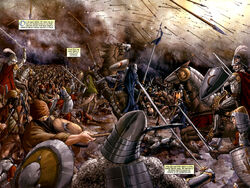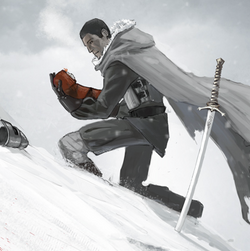
A portion of the Battle of the Shining Walls.
- For other uses of the term "Shining Walls," see Shining Walls. For other uses of the words "blood" and "snow," both part of another name for this battle, see Blood and Snow.
The Battle of the Shining Walls was the final and decisive battle of the Aiel War, fought in the final month of 978 NE outside the Shining Walls of Tar Valon, between four clans of the Aiel and armies from ten of the fourteen kingdoms of the Westlands, who had been unified as the grandiosely-titled Grand Alliance.
Those who remember the battle have labelled it the Blood Snow, particularly those who participated in it as it was fought in freezing winter conditions, and the loss of life in the battle was tremendous.
Background[]
By this time, the Aiel War had already been raging for two years. The Aiel had learned that King Laman Damodred of Cairhien had destroyed Avendoraldera, a sapling of the Tree of Life they had given to the Cairhienin in gratitude for their help in ensuring their survival during the Breaking of the World (this event having occurred 3,000 years earlier, the Cairhienin had no knowledge of it). Outraged, the Aiel sent four clans across the Spine of the World to gain revenge upon the 'Treekillers'. Cairhien had been defeated and devastated, its frontier fortresses destroyed and the capital city put to the torch. The shattered remnants of the Cairhienin army had fled south, gaining support from Tear along the way, and then west across the River Erinin, where they gained more troops from Andor.
Thanks to Aes Sedai negotiation, many of the other nations had assembled their armies at Tar Valon to face the Aiel threat. By the final month of 978 NE, the so-called Grand Alliance had assembled to meet the enemy in battle.
Composition of forces[]
The Grand Alliance mustered approximately 170,000 troops, consisting of the following contingents:
- 29,000 from Shienar under Lord Agelmar Jagad.
- 28,000 from Andor under Lord Aranvor Naldwinn.
- 26,000 from Illian under King Mattin Stepaneos den Balgar.
- 24,000 from Tear under the High Lord Astoril Damara.
- 21,000 from Arafel under Lord Hirare Nachiman.
- 12,000 from Tar Valon under Captain Azil Mareed.
- c. 7,000 from Cairhien under King Laman Damodred.
- 5,000 from Ghealdan under Lord Aleshin Talvaen.
- 4,000 from Amadicia under Lord Aeman Senhold.
- 4,000 of the Children of the Light under Lord Captain Commander Pedron Niall.
- c. 4,000 from Murandy under a rotating council of nobles.
- 3,500 from Altara under a rotating council of nobles.
- an unknown number of mercenaries, irregulars and minor forces from other countries, including a small force from Arad Doman under General Rodel Ituralde, a detachment of the Winged Guards of Mayene and even some surviving veterans of Malkier under al'Lan Mandragoran.
In addition, mercenaries and irregulars from the remaining nations and city-states also fought. Armies from Saldaea and Kandor had set out to join the Alliance, but been recalled to deal with a fresh incursion of Shadowspawn out of the Blight.
In contrast, the Aiel only numbered between 70,000 and 80,000 warriors of the Taardad, Reyn, Nakai and Shaarad clans, including a significant number of Aiel Maidens of the Spear. The presence of the Maidens surprised many of the Western troops, who had never faced women in battle before.
Leadership[]
The Grand Alliance had initially compromised on Lord Agelmar Jagad of Fal Dara as their field commander, based on his sterling reputation in battle, Shienar's success in raising and sending the largest possible army and the Borderlands' aloofness from the political intrigue in the southern kingdoms which made other choices unacceptable to certain participants. However, King Laman of Cairhien was vehement that he should command, as Cairhien had suffered the most from the depredations of the Aiel invasion. After some extremely unbecoming bickering, it was decided to rotate command between the commanders of the different armies as a compromise measure.
In contrast, the four Aiel clans had submitted themselves to the military authority of Janduin, clan chief of the Taardad Aiel and the architect of the invasion. The Aiel's much simpler command structure may have contributed to them holding their own against considerably larger numbers (though the quality of the Aiel warriors was undoubtedly grossly superior to many of the Westland fighting men).
The battle[]
The first two days of the battle saw heavy fighting around the banks of the River Erinin. Although the Alliance force had more than twice as many men as the Aiel, they were deployed to prevent a potential attack from any direction, and its unwieldy size prevented it from bringing overwhelming force to bear at any one point. To make matters worse, the Alliance was simultaneously forced to both defend the largest city on the continent and attempt to rout the attacking Aiel. Further complicating this was the fact that the Alliance commanders had no idea what the true objective of the Aiel forces actually was; they believed that the Aiel were attempting to overrun them and ransack Tar Valon, but the Aiel were simply there to kill Laman. As such, the Alliance's tactical concerns were completely misguided, since all the Aiel were concerned with was identifying Laman's location and killing him.
The first two days of the battle were an indecisive bloodbath, with both sides suffering horrendous numbers of casualties. Despite their logistical and tactical issues, and the significantly greater number of casualties on their side, the Alliance commanders Lord Agelmar Jagad and Lord Captain Commander Pedron Niall managed to hold their own against the Aiel.
On the third day the Aiel scored a notable success by killing Lord Captain Aranvor Naldwinn, commander of the Andoran contingent, which plunged the Alliance into some confusion during the time it took them to select a replacement. During this confusion, the Aiel forces finally identified Laman's standard and made a beeline to attack him. Laman was beheaded, and his Power-wrought sword was taken as a trophy of victory. Their only objective accomplished, the Aiel then executed an extremely well-organized withdrawal over the river by night and began a rapid retreat towards the Aiel Waste. This move took the Alliance completely by surprise; neither side had achieved a decisive victory so far, and there seemed to be no tactical explanation for their withdrawal. Assuming that the Aiel had judged victory against them to be impossible, the Alliance forces mounted a pursuit as quickly as they could.
The pursuit[]
Believing they had the Aiel on the run, the Alliance armies "drove" the Aiel south and east towards Kinslayer's Dagger. The Aiel fought several rearguard actions involving thousands of troops which succeeded in preventing the Alliance forces from catching up with the Aiel's main host. Lord Hirare Nachiman, commander of Arafel's troop detachment, was killed during one of these pointless engagements.
Twenty days after Laman's death, the main Aiel force reached Kinslayer's Dagger and melted away into the mountains, and thence back into the Aiel Waste.
Conclusion[]
In the aftermath, both sides declared victory. As the Alliance commanders believed that the Aiel had crossed the Dragonwall to lay waste to the Westlands, they believed they had shown the Aiel their mettle on the battlefield and forced them to retreat. However, it did not take long for them to realize the correlation between the timing of Laman's death and the Aiel's abrupt departure. Despite the realization that the Alliance had had nothing to do with the Aiel retreat, none of its commanders wanted to popularize that fact due to how humiliating the rest of the war had been for the Westland forces. While the popular image of a great victory over the Aiel lived on in the Westlands, many who were either involved in the battle or who were educated came to realize that all the Aiel had wanted was Laman's death, and that they had simply left once that aim was achieved.
The Aiel declared that their objectives had been fulfilled and vengeance had been satisfied, but they did not seem to take great pleasure in the carnage they had unleashed. Janduin, in particular, was heartbroken as his pregnant lover, Shaiel had vanished in the battle and been presumed dead. In his despair, he renounced his position as a clan chief. Though he was told by his astounded peers that he could not do such a thing, he simply walked away and traveled to the Blight, where he hoped to lose his life fighting against the ever-present forces of the Shadow.
The Dragon is Reborn[]
During the third day of the battle, a detachment of the Illianer Companions, the elite formation of the Illianer army, engaged a force of Aiel Maidens of the Spear who had been cut off from their main force. The Aiel Maidens made their stand on the slopes of Dragonmount itself and were cut down, although not before inflicting some losses on the Illianer forces. Whilst examining the dead women, Second Captain Tam al'Thor, an Andoran from the Two Rivers, found that one of them had died giving birth. The child survived. Tam decided to take the child as his own, naming him Rand, eventually taking him home to the Two Rivers.

Tam al'Thor finds little Rand
At the moment Rand was born on the slope of Dragonmount, where Lews Therin Telamon had died more than three thousand years earlier, Gitara Sedai the Keeper of the Chronicles, uttered a Foretelling that the Dragon had been Reborn, and dropped dead on the spot. The only witnesses were the Amyrlin Seat, Tamra Ospenya, and two of the Accepted, Moiraine Damodred and Siuan Sanche. These two women would dedicate the next twenty years to finding the Dragon Reborn before the forces of the Shadow did.
Consequences[]
After the battle, the Grand Alliance failed to become a permanent organization as Grey Ajah hoped and disintegrated, its armies returning to their various homelands.
When the Cairhienin noble houses learned that Laman's pride in cutting down Avendoraldera had directly led to the Aiel devastating their nation, they deposed House Damodred from the Sun Throne. In the Fourth War of Cairhienin Succession, Lord Galldrian Riatin gained the upper hand and ascended the throne. Cairhien spent much of the next two decades recovering from the war and rebuilding its cities, economy and army.
Though it was never directly confirmed, Janduin was later reported to have been slain in the Blight by a man who was reported to have looked so similar to Shaiel that Janduin could not raise his hand against him.
Shortly after the battle, the leader of the Black Ajah, Jarna Malari kidnapped and tortured Tamra Ospenya before killing her. The Black Ajah thus learned that the Dragon had been Reborn, but not that he had been born during the battle. As a result, they spent the next half-decade desperately searching for young men or boys rather than an infant, allowing Rand al'Thor to escape detection. However, scores of innocent children, including Prince Diryk of Kandor, were murdered by the Black Ajah in their ignorance.
Ultimately, it was the rebirth of the Dragon that proved to be the enduring legacy of the battle. Rand al'Thor began his ascension to rule the Westlands in 998 NE, so the countdown to the Last Battle could be said to have begun with the Battle of the Shining Walls.